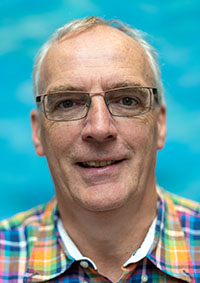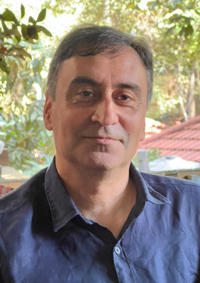Bornholm (21-28.08.2025)
Lecturers: Dierk Hebbeln, Mahyar Mohtadi
The geologic structure of Bornholm, in contrast to the rest of Denmark, is predominantly dominated by Precambrian basement rocks, which form a geological unit with southern Sweden. The horst structure of Bornholm is located at the suture (Tornquist-Teisseyre zone) between the Eastern European Platform/Fennoscandian Shield and Central Europe and is strongly influenced by the Caledonian orogeny.
The near-surface geological bedrock of central and northern Bornholm is formed by Precambrian gneisses and granites estimated to be 1.4 billion years old. The rocks in the southwest of Bornholm are weathering remains and sedimentary rocks from the Paleozoic and the Mesozoic. The southeast of the island is formed by Old Palaeozoic sedimentary rocks (`Kambrosilur`), which have been deformed during the Caledonian orogeny. Mesozoic sedimentary rocks form the transition to bedrock in the entire southwest of the island.
Large-scale Quaternary deposits occur mainly in the form of sand dunes in the southeast of Bornholm. The surface landforms of the entire island were shaped by Pleistocene glaciers.
The overall aim of this excursion is to gain an in-depth understanding of the changing geological history of this island, which lies at the junction of the East European Platform/ Fennoscandian Shield and the North European Depression, over a comparatively large section of the Earth`s history. Special features are excellent outcrops from the older and younger Precambrian, the Palaeozoic and the Mesozoic. By contrast, Upper Palaeozoic rocks, which were Variscan deformed and are typical for large parts of Central and Southern Europe, are largely absent.
In detail, the following main topics will be dealt with:
- Precambrian granites and gneisses
- Sedimentology and fossil content of the Palaeozoic
- Caledonian orogeny and plate tectonics
- Mesozoic successions in relation to major tectonics
- tectonic inventory of the Tornquist-Teisseyre zone
- Cretaceous sedimentation
- Quaternary sequences
- Glacial morphology and coastal landforms
Report on a topic of the field trip
field trip report
There will be a field trip guide for the field trip, which will be made available on the web shortly before the start of the field trip.
Gravesen, P. (1996) Bornholm, Geografforlaget, Brenderup, 201 p. (in Danish)
Gravesen, P. (1984) Guide to excursion to Bornholm, DGU Series C, no. 3. Geol. Survey Denmark, 84 p.
Gensbol, B. (1991) Bornhom - A Nature Guide, Denmark, 175 p.
1st Day: Travel to Bornholm, general introduction to the geology of Bornholm
2nd Day: The Precambrian of Bornholm - part 1
3rd Day: The Precambrian of Bornholm - part 2
4th Day: The Cambrian of Bornholm
5th Day: Ordovician, Silurian, Triassic of Bornholm
6th Day: The Mesozoic (Jurassic and Cretaceous) of Bornholm
7th Day: The Meso-Cenozoic (Cretaceous and Quaternary) of Bornholm
8th Day: Return to Bremen
9th Day:
10th Day:
11th Day:
12th Day:
13th Day:
14th Day:
Basic Data
05-BGW-GF1-3
Study Program
Bachelor Geowissenschaften
Module Name
Geoscientific Field Competence
Course Type
Field Exercise (F)
2. Year of Study
3 CP
3.5 SWS
Sommersemester
Course Language
German
Contact Person

Marine Sedimentology
Prof. Dr. Dierk Hebbeln
MARUM2 3180R
Phone: +49 421 218 - 65650
dhebbeln marum.de
marum.de
Marine Sedimentology
Prof. Dr. Dierk Hebbeln
MARUM2 3180R
Phone: +49 421 218 - 65650
dhebbeln marum.de
marum.deLecturer

Prof. Dr. Dierk Hebbeln
MARUM2 3180
Phone: +49 421 218 - 65650
dhebbeln marum.de
marum.de
Prof. Dr. Dierk Hebbeln
MARUM2 3180
Phone: +49 421 218 - 65650
dhebbeln marum.de
marum.de
PD Dr. Mahyar Mohtadi
MARUM2 3100
Phone: +49 421 218 - 65660
mohtadi uni-bremen.de
uni-bremen.de
PD Dr. Mahyar Mohtadi
MARUM2 3100
Phone: +49 421 218 - 65660
mohtadi uni-bremen.de
uni-bremen.de
